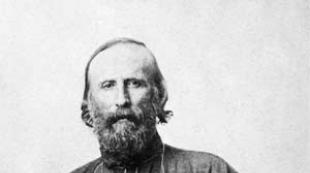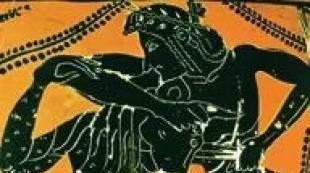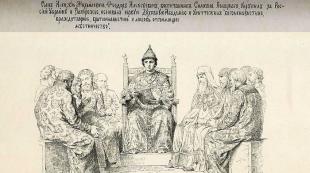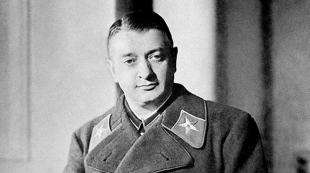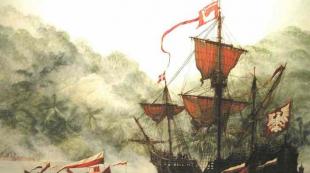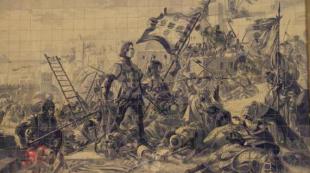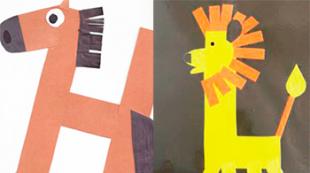Guess the puzzles and explain the meaning of economic terms. Mind recharge! Learning to solve puzzles. How to solve puzzles from pictures
The mystery of puzzles.
Rebus (from Latin"rebus" - “with the help of things”), the representation of a word or syllable with the help of an image of an object, the name of which is consonant with the presented word or syllable. Simply put, this is a riddle in which the unraveled words or expressions in the form of drawings are combined with letters and some other signs.
Several puzzles can be combined in one drawing or as a sequence of drawings in order to make up a phrase or sentence. In literary puzzles, letters, numbers, musical notes, or specially arranged words are used to compose sentences. Compound puzzles include pictures and letters. Rebuses can convey the direct meaning of words, mainly to inform or instruct illiterate people, or deliberately hide their meaning in order to inform only the initiates, or when used as a riddle and entertainment.
An early form of the rebus is found in pictorial writing, in which abstract words that are difficult to depict were represented by images of objects whose names were pronounced in a similar way. Such puzzles are similar to the hieroglyphs of Egypt and the pictographs of early China. Images of rebuses were used to convey the names of cities on Greek and Roman coins, or to represent family names in the medieval age.
The history of puzzles :
The first puzzles appeared in France in XV century. Then it was a farcical performance on the topic of the day. In an allegorical form, comedians ridiculed the vices and weaknesses of the powerful of this world, told "about the things that are happening." Over time, the nature of the rebus has changed. A rebus began to be called a pun built on a play on words.
Around the same time, the first drawn puzzles appeared. Initially, they literally illustrated well-known phraseological turns, later more complex variants appeared.
V XVI century, drawn puzzles become known in England, Germany, Italy, but in none of these countries have they been widely developed.
Professional artists took part in their design. The first printed collection of puzzles compiled by Etienne Tabouraud, appeared in France in 1582.
In Russia, puzzles appeared later - in the middle XIX century, the first puzzles appeared on the pages of the magazine "Illustration" in 1845. Puzzles drawn by the artist were very popular Volkov in the Niva magazine. In the future, a special magazine "Rebus" began to appear.
About the benefits of solving puzzles :
“We know a lot of serious people,” one of the magazines wrote, who gladly devote hours of leisure to solving puzzles and especially recommend this activity to young people as a distinctive gymnastics for the mind ... ". It also hones ingenuity, develops the ability to bring the work begun to the end, and contributes to the activation of people's communication.
Riddles for children have many positive aspects:
- Contribute to the development of thinking.
- They train intelligence, logic, intuition, ingenuity.
- Help the child to broaden his horizons, memorize new words, objects.
- They train visual memory, spelling Unlike the usual riddle, which uses only a verbal description in poetry or prose, rebuses combine several methods of perception at once, both verbal and visual.
Types of puzzles .
- Puzzle puzzles represent a double task: having solved the rebus, you will read the riddle, but the riddle must be solved.
- Puzzles "add and subtract" differ from the usual ones in that the value of the image following the minus sign is not added to the already received combination of words, but subtracted from it.
- Rebus jokes- This is a comic riddle in verse.
- Rebus proverbs are an encrypted proverb that needs to be unraveled and its meaning explained.
- sound puzzle- these are puzzle exercises that allow you to work out the skill of merging syllables.
- Rebus story consists of a big puzzle that you need to solve and make up a story.
- Rebus problem- This is a puzzle that you need to solve and solve the problem. It consists of several puzzles.
- Numerical puzzles- these are puzzles that improve the ability to understand and comprehend the positional principle when writing numbers in the decimal system.
Rules for solving puzzles :
- a word or sentence is divided into such parts that can be depicted in the form of a picture
- the names of all the objects shown in the figure should be read only in the nominative case;
- if the object in the picture is turned upside down, its name is read from right to left;
- if there are commas (one or more) to the left of the figure, then the first letters of the word are not read. If commas are after the figure, to the right of it, the last letters are not read;
- if a crossed-out letter is shown above the figure, it must be excluded from the name of the subject;
- if there are numbers above the figure, the letters should be read in the indicated order;
- if another letter is written next to the crossed out letter, it should be read instead of the crossed out one. Sometimes in this case an equal sign is placed between the letters;
- if part of the word is pronounced as a numeral, in the rebus it is depicted by numbers and numbers (O5 - again; 100G - haystack);
- if the drawing does not have any additional characters, only the first letter of the name of the depicted object should be taken into account;
- many parts of encrypted words are indicated by the corresponding arrangement of letters and drawings. Words that have a combination of letters on, under, over, behind, can be depicted by placing letters or objects one above the other or behind the other. The letters C and B can become prepositions. If the letter is made up of other letters, the preposition from is used when reading.
Rules for compiling puzzles :
1. The names of all the items depicted in the rebus, are read only in the nominative case and singular. Sometimes the desired object in the picture is indicated by an arrow.
2. Very often, the object depicted in the rebus may have not one, but two or more names, for example, “eye” and “eye”, “leg” and “paw”, etc. Or it may have one general and one specific name, such as "tree" and "oak", "note" and "re", etc. You need to choose the one that makes the most sense.
The ability to identify and correctly name the object depicted in the figure is one of the main difficulties in deciphering puzzles. In addition to knowing the rules, you will need ingenuity and logic.
3. Sometimes the name of any subject cannot be used in its entirety - it is necessary drop one or two letters at the beginning or end of a word. In these cases, a conventional sign is used - a comma. If a comma is to the left of the figure, then this means that the first letter must be discarded from its name, if to the right of the figure, then the last. If there are two commas, then two letters are discarded accordingly, and so on. for instance, a “collar” is drawn, only “whirlpool” needs to be read, “sail” is drawn, only “steam” needs to be read.

4. If any two objects or two letters are drawn one into the other, then their names are read with adding the preposition "in". for instance: "v-o-yes", or "not-v-a, or" v-o-seven":

In this and the following five examples, various readings are possible, for example, instead of"Eight" can be read "SEVEN", and instead of "water" - "DAVO" . But there are no such words! This is where you should come to the rescue. ingenuity and logic.
5. If any letter consists of another letter, then read from adding "from". for instance: “from-b-a” or “vn-from-y” or “f-from-ik”:



6. If there is another letter or object behind any letter or object, then you need to read with adding "for".
For example: “Ka-za-n”, “za-ya-ts”.


7. If one figure or letter is drawn under another, then you need to read from adding "on", "above" or "under"- choose a sentence that makes sense. for instance: “for-on-ri” or “under-at-shka”:


The phrase: "Tit found a horseshoe and gave it to Nastya" - can be depicted as follows:

8. If another letter is written for any letter, then they read from adding "by". for instance: “by-r-t”, “by-l-e”, “by-i-s”:

9. If one letter lies next to another, leaning against it, then they read with adding "y". for instance: "L-u-k", "d-u-b":

10. If in the rebus there is an image of an object drawn upside down, then its name is needed read from the end. for instance, a “cat” is drawn, you need to read “current”, a “nose” is drawn, you need to read “dream”.

11. If an object is drawn, and a letter is written next to it, and then a letter is crossed out, then this means that this letter is necessary discard from received word. If there is another one above the crossed out letter, then this means that you need it replace the crossed out. Sometimes in this case an equal sign is placed between the letters. for instance: "eye" read "gas", "bone" read "guest":


12. If there are numbers above the picture, for example, 4, 2, 3, 1, then this means that read first the fourth letter of the name of the object shown in the figure, then the second, followed by the third, etc., that is, the letters are read in the order indicated by the numbers. for instance, a “mushroom” is drawn, we read “brig”:

13. If two numbers are shown next to the picture with arrows pointing in different directions, then the word must interchange the letters indicated by the numbers. for instance, "castle" = "dab".

14. The use of an arrow going from one letter to another also serves to indicate the appropriate substitution of letters. Also, the arrow can be decoded as preposition "K". for instance, “The letters AP go to FIR-tree” = “DROPS”

15. When compiling a rebus, Roman numerals can also be used. for instance, "forty A" read "forty".

16. If any figure in the rebus is drawn running, sitting, lying, etc., then the corresponding verb in the third person of the present tense (runs, sits, lies, etc.) must be added to the name of this figure, For example"u-runs".

17. Very often in rebuses, individual syllables “do”, “re”, “mi”, “fa” are depicted with the corresponding notes. for instance, the words written down in notes are read: “do-la”, “fa-sol”:

Since not everyone knows the notes and the position on the stave, we give their names.

Other signs are possible in rebuses: names chemical elements, all kinds of scientific terms, special characters: "@" - dog, "#" - sharp, "%" - percentage, "&" - ampersand, "()" - brackets, "~" - tilde,« :) » - emoticon, "§" - paragraph and others.
In complex puzzles, the listed techniques are most often combined.

"The red maiden sits in a dungeon, and the scythe is on the street"
puzzles is a means of increasing information culture. With self-compilation of puzzles, information search skills, creativity, and intellectual abilities develop.
Who among us is not familiar with puzzles? These entertaining ciphers are familiar to everyone from young to old. In puzzles, words are encrypted using a sequence of pictures and different symbols, including letters and numbers. The word "rebus" is translated from Latin as "with the help of things." The rebus originated in France in the 15th century, and the first printed collection of puzzles published in this country in 1582 was compiled by Etienne Taburo. In the time that has passed since then, the technique of compiling rebus problems has been enriched with a variety of different techniques. To solve the rebus, it is important not only to know what is drawn, but also to take into account the location of the drawings and symbols relative to each other, and this is achieved by practice. There are some unspoken rules by which puzzles are made up, and it is easier to solve them also according to the same rules, and the rules are as follows:
General rules for solving puzzles
The word or sentence in the rebus is divided into parts, which are depicted in the form of a picture or symbol. The rebus is always read from left to right, less often from top to bottom. Spaces and punctuation marks are not read. What is drawn in the pictures in the rebus is read in the nominative case, usually in the singular, but there are exceptions. If several objects are drawn, the arrow indicates which part of the entire image is used in this rebus. If not one word is guessed, but a sentence (proverb, catchphrase, riddle), then in addition to nouns there are verbs and other parts of speech. Usually this is specified in the task (for example: “Guess the riddle”). The rebus must always have a solution, and one. The ambiguity of the answer should be specified in the conditions of the rebus. For example: “Find two solutions to this puzzle.” The number of techniques used in one rebus and their combinations is not limited.
How to solve puzzles from pictures
They name all objects sequentially from left to right in the nominative singular.
Answer: track experience = tracker

Answer: ox box = fiber

Answer: eye of the face = outskirts
If the object is drawn upside down, its name should be read from right to left. For example, a “cat” is drawn, you need to read “current”, a “nose” is drawn, you need to read “dream”. Sometimes reading directions are shown with an arrow.

Answer: dream
Often an object drawn in a rebus can be called differently, for example, “meadow” and “field”, “leg” and “paw”, “tree” and “oak” or “birch”, “note” and “mi”, in such cases, you need to select a suitable word, such that the rebus has a solution. This is one of the most important difficulties in solving puzzles.

Answer: oak rava \u003d oak grove
How to solve puzzles with commas
Sometimes the name of the item depicted cannot be used in its entirety and one or more letters at the beginning or end of the word must be dropped. Then a comma is used. If a comma is to the left of the figure, the first letter is discarded from its name, if it is to the right, the last. How many commas are worth, so many letters are discarded.

Answer: ho ball k = hamster
For example, 3 commas and a “feeder” are drawn, you only need to read the “fly”; “sail” and 2 commas are drawn, you only need to read “steam”.

Answer: Umbrella p = pattern

Answer: li sa to por gi = boots
How to solve puzzles with letters
Such letter combinations as before, above, on, under, behind, at, at, in, as a rule, are not depicted in puzzles, but are identified from the corresponding position of letters and drawings. Letters and letter combinations from, to, from, from, to, and are not shown, but the relationship of letters or objects, or direction.
If two objects or two letters, or letters and numbers are drawn one into the other, then their names are read with the addition of the preposition "in". For example: “v-o-yes”, or “v-o-seven”, or “no-v-a”. A different reading is possible, for example, instead of "eight" you can read "seven-in-o", and instead of "water" - "yes-in-o". But such words do not exist, therefore such words are not a solution to the rebus.

Answers: v-o-yes, v-o-seven, v-o-lx, v-o-ro-n, v-o-mouth-a
If one object or symbol is drawn under another, then we decipher it with the addition of “on”, “above” or “under”, you need to choose a preposition according to the meaning. Example: “fo-na-ri”, “under-at-shka”, “above-e-wa”.

Answers: for-on-ri, under-at-shka, over-e-wa
If behind any letter or object there is another letter or object, then you need to read with the addition of “for”. For example: “Ka-za-n”, “za-ya-ts”.

Answer: for-i-c
If one letter lies next to another or is leaning against it, then they read with the addition of "y" or "k". For example: “L-u-k”, “d-u-b”, “o-k-o”.

Answers: onion, oak
If a letter or syllable consists of another letter or syllable, then read with the addition of "from". For example: “from-b-a”, “b-from-he”, “out-of-y”, “f-from-ik”.


Answers: hut, bison
If another letter or syllable is written throughout the letter, they read with the addition of “by”. For example: “po-r-t”, “po-l-e”, “po-i-s”. Also, "by" can be used when one letter with legs runs over another letter, number or object.

Answer: Poland

Answers: belt, field
If an object is drawn, and a letter is written next to it, and then a letter is crossed out, this means that this letter must be thrown out of the word. If there is another one above the crossed out letter, then this means that it is necessary to replace the crossed out one with it. Sometimes in this case an equal sign is placed between the letters.

Answer: laz

Answer: raspberry z Mont \u003d lemon
How to solve puzzles with numbers
If there are numbers above the picture, this is a hint in what order to read the letters from the name of the subject. For example, 4, 2, 3, 1 means that the fourth letter of the name is read first, then the second, followed by the third and first.

Answer: brig
The numbers can be crossed out, which means you need to discard the letter corresponding to this order from the word.

Answer: horse ak LUa bo mba = Columbus
Quite rarely, the action of the letter is used in rebuses - it runs, flies, lies, in such cases, the corresponding verb in the third person of the present tense must be added to the name of this letter, for example, “y-runs”.
How to solve puzzles with notes
Often in rebuses, individual syllables corresponding to the names of notes - “do”, “re”, “mi”, “fa” ... are depicted with the corresponding notes. Sometimes the generic word "note" is used.

Notes used in composing puzzles


Answers: beans, minus
In order for the logic and brain to work actively, training is necessary. An excellent training option would be solving crosswords and puzzles. Puzzles are the easiest and most colorful option available even for children. But in order to solve it, you must follow some rules.
How to solve puzzles - how to read from pictures
Pictures in puzzles you need to read from left to right. In rare cases, the rebus is encrypted from top to bottom. Read the picture in the singular, use the nominative case, name the objects from left to right in the order in which they are located. Name an inverted object in reverse, reading the name from right to left.


How to solve puzzles - reveal the secret of commas in the rebus
Commas are used to remove a letter from a word. The number of excluded letters is equal to the number of commas. See where the comma is. If it is to the right of the picture - do not pronounce the last letter, to the left - discard the first.


How to solve puzzles - ciphers with letters
In letter puzzles, prepositions are usually used to indicate location. They are not displayed in letters in the picture, you should identify them, judging by the location of the letters in the puzzle. Look at the puzzle carefully. If you saw that two letters fit inside one large one, then you will read the rebus with the preposition "in". If one image hangs above another or is located below it, it is necessary to read “above” or “under”, respectively.
A rebus in which a letter is hidden behind another will be pronounced with the preposition "for". You can also notice puzzles in which one letter leaned against another. Read the rebus with the addition of "k" or "y". How to read a rebus where one letter consists of many others? With the addition of the preposition "of". Also, if others are written in one huge letter, such a rebus is read by adding “by”. "By" is also used to read puzzles, where one number runs over another.
If you notice a crossed-out letter in the picture near the item, then you should exclude this letter from the name of the item. If you notice another one above the crossed out letter or an equal sign is placed between them, then you should replace another with this letter.


How to solve puzzles - puzzles and numbers
The numbers above the picture in a certain sequence indicate to you in what order to pronounce the name of the subject. If the number is crossed out, do not pronounce the letter located on the account corresponding to the number in this word.


How to solve puzzles - deal with notes
The syllables that correspond to the notes are depicted in the rebus by these notes. Sometimes they just use the word "note".


Knowing the rules for deciphering puzzles and applying them in practice, you can start interesting quests in the company. For quick guessing, not only knowledge of the rules is necessary, but also a lot of practice. Puzzles are what will help the brain work more actively, and you will have fun in the company.
Ready? Go!
 2.
2.
 3.
3.
 4
4
 5.
5.
 6.
6.
And here you have to puff a little longer: you need to unravel the whole proverbs:
 7.
7.
 8.
8.
 9.
9.
Well, the last task for real pros! Guess which phrase is encrypted here:
 10.
10.
How to solve puzzles? Recall a few rules:
1. The name of all objects depicted in the figures should be read in the nominative case.
2. Commas before a picture or a word mean how many letters to remove from the beginning of the word.
3. Commas (usually inverted) after a picture or word indicate how many letters to remove from the end of the word.
4. Crossed out letters mean that such letters must be removed from the word. If there are several such letters in the word, then all of them are crossed out.
5. The crossed out numbers of letters mean that it is necessary to cross out only the letters with the corresponding serial number from the beginning of the word.
6. An equality of type AND=E means that all letters AND in the word should be replaced by E. If an equality of type 1=C is indicated, then only the first letter should be replaced by C. (P=S SAW - POWER)
7. The use of an arrow going from one letter to another also serves to indicate the appropriate substitution of letters. A-P
8. The numbers 3,1,4,5 above the figure mean that from the word it is necessary to use only letters numbered 3,1,4,5 and in the order of the numbers.
9. A picture turned upside down means that the word must be read backwards.
10. If a fraction is used in the rebus, then this stands for "ON" (divide ON). If a fraction with a denominator of 2 is used, then this stands for "FLOOR" (half).
11. In puzzles, when encrypting, they often use notes. Specify their name.
12. If the pictures are placed one under the other, then this stands for "ON", "OVER", "UNDER".
13. A letter made up of other letters stands for "FROM". If in small letters "B" we depict a large "A", then we get "FROM B A"
14. A letter written on top of another stands for "PO".
15. If one letter is depicted behind another letter, then this is deciphered as "FOR" or "BEFORE".
16. If an arrow is drawn above the picture with a point to the left, then first you need to decipher the word, and then read it backwards.
17. The crossed out sign "=" between the pictures should be read as "NOT" (Example: "C" is NOT equal to "G").
Well, now the answers:
1. St. Petersburg
2. Supermarket
3. Start
4. Tournament
5. Classic
6. Compote
7. God saves the safe
8. Out of sight, out of mind
9. Language will bring to Kiev
10. If you are suddenly bitten by a crocodile, then you just need to press hard on his eyes and he will let you go
To learn how to compose and understand puzzles, it is worth understanding what they are.
Word "rebus" of Latin origin (lat. rebus, with the help of things, "Non verbis sed rebus" - "Not with words, but with the help of things"). The rebus originated in France in the 15th century, and the first printed collection of puzzles published in this country in 1582 was compiled by Etienne Taburo. In the time that has passed since then, the technique of compiling rebus problems has been enriched with a variety of different techniques.
So, rebus- this is one of the types of puzzles, a riddle for deciphering words. Encrypted according to certain rules in a rebus can be not only a single word, but also a proverb, saying, quote, riddle, and even a whole short story. Words and phrases in the rebus are depicted in the form of pictures, letters, numbers, notes and other various signs, the number of which is not limited. Solving the rebus is a whole science. When solving a rebus, it is necessary to write down all the signs in the form of a meaningful word or sentence. Although there are several types of puzzles (literary, mathematical, musical, sound, etc.), there are some general rules for compiling and solving them.
rebus example

GENERAL RULES FOR SOLVING PUZZLES
A word or sentence is divided into such parts that can be depicted in the form of a picture or any sign. The rebus is read from left to right, less often from top to bottom. Punctuation marks and spaces in the rebus are not taken into account. If one word is guessed in the rebus, then it should, as a rule, be a noun, moreover, in the singular and in the nominative case. Deviation from this rule must be stipulated in the conditions of the rebus. If a sentence is guessed (proverb, aphorism, etc.), then, naturally, it can contain not only nouns, but also verbs and other parts of speech. In this case, the conditions of the rebus must contain the appropriate phrase (for example: “Guess the riddle”). The rebus must have a solution, and, as a rule, one. The ambiguity of the answer should be specified in the conditions of the rebus. For example: “Find two solutions to this puzzle.” The number of techniques used in one rebus and their combinations is not limited.
REBUSES IN PICTURES
The simplest option, when the rebus consists of two pictures to help you create a new word. The names of the objects depicted in the rebus should be read in the nominative singular or plural if several objects are depicted.
rebus 1

OX + WINDOW = FIBER
rebus 2

TRAIL + EXPERIENCE = TRAILER
rebus 3

EYE + FACES = EYE
From the last example, it can be seen that the picture in the rebus can have more than one name (eye and eye, bees and swarm, etc.); or the image may have a general or private name (a bird is a common name; a swift, a swallow, a chicken is a private name). If the depicted object has two meanings, then it is logically necessary to determine the appropriate one. This is the hardest part of puzzles.
If the picture turned upside down, which means that the word is read backwards.
rebus 4

Inverted NOSE = SLEEP
If to the right or left of the picture is one or more letters- this means that these letters should simply be added. Sometimes they are preceded by a "+" sign. Sometimes the desired object in the picture is indicated by an arrow.
rebus 5

FLASK + SA = SAUSAGE
rebus 6

Letter X + LION = SHED
REBUSES WITH COMMA
commas to the right or left of the picture means that in the word conceived with the help of the picture, you need to remove as many letters as there are commas. At the same time, commas in front of the picture indicate how many letters need to be removed at the beginning of the hidden word, commas at the end of the picture indicate how many letters need to be removed from the end of the word. Sometimes the commas to the left of the image are drawn upside down, although this does not play a fundamental role.
rebus 7

VOL K - K = VOL
rebus 8

GA MAC - GA = MAC
rebus 9

BA RAB AN - BA - AN = RAB
The arrow pointing to the left above the picture indicates that after the word is deciphered, it must be read backwards.
rebus 10

DRESSER - KO, read from right to left = HOUSE
REBUSES WITH LETTERS AND NUMBERS
If above the picture is strikethrough letter, and there is another one nearby, then this letter in the word must be changed to the specified one. If one or more letters are simply crossed out, then they must be removed from the given word. The "=" sign also serves to replace one of the letters with another.
rebus 11

O R YOL \u003d Donkey
rebus 12

BA BARREL - BA = BARREL
rebus 13

KORO B A = CROWN
If the crossed out letter(s) stands as an independent figure, then it must be read with the addition of the “not” particle.
rebus 14

NOT UCH
Numbers can be used instead of a picture. If part of the word in the rebus is represented by a number, then the number is pronounced as a numeral.
rebus 15

Number SEVEN + letter I = FAMILY
rebus 16

STO number + letter L \u003d TABLE
Keep in mind that a number can have more than one name.
rebus 17

ONE + FORK = FORK
rebus 18

Letter W + QOL + letter A = SCHOOL
rebus 19

Letter P + ONE + AR KA \u003d MELLE
rebus 20

ON VAR + figure TWO + L EU \u003d BASEMENT
Several identical letters or other images in a row mean that you need to try to count them.
rebus 21

SEVEN letters I = FAMILY
rebus 22

THREE CATS + letter F = JERSEY
rebus 23

PAIR of letters D = PARADE
Numbers next to the picture are used to number the letters in a word. The number indicates the place of the letter in the given word, and the order in which the numbers are written determines the new place of this letter.
rebus 24
PINE = PUMP
rebus 25

PAINTER = GAUGE
If there are fewer numbers than letters in the hidden word, this means that only the specified number of letters must be selected from the hidden word.
rebus 26

A LL IGAT O R = GUITAR
The use of crossed out numbers means that the corresponding letters must be removed from the hidden word.
rebus 27

PAL AT KA = STICK
If two numbers are shown near the picture with arrows pointing in different directions, then in the word it is necessary to swap the letters indicated by the numbers.
rebus 28

Z A M OK \u003d SMAMA
Roman numerals may also be used.
rebus 29

Forty A = FORTY
The use of fractions is not excluded. When a fraction is used in a rebus, it is unraveled as "ON THE"(divide by). If a fraction with a denominator 2 is used in the rebus, then this is unraveled as "FLOOR"(half).
rebus 30

Z divide by K \u003d SIGN
rebus 31

Gender of letter E = FIELD
crossed out sign "=" between pictures should be read as "NOT".
rebus 32

And not Y \u003d hoarfrost
PUZZLES BY THE TYPE "LETTERS IN A LETTER", "LETTERS ON OR UNDER THE LETTER"
Often in puzzles, letters are drawn placed in an unusual perspective relative to each other (one inside the other, one under or above the other, one runs towards the other, one goes out of the other, etc.). This means that it is necessary to describe a drawing or letter combinations using prepositions, unions: “I”, “B”, “K”, “U”, “C”, “FOR”, “FROM”, “ON”, “ON” , "BEFORE" and others.
If objects, numbers or letters are depicted one in the other, then their names are read with the addition of a preposition "V" before or between titles.
rebus 33

In the letter O, the letter Z = WHO
rebus 34

The letter Z in the letter O + the letter H \u003d CALL
If one object is depicted after another, then their names are read with the addition of a preposition "FRONT" or "PER".
rebus 35

Behind the letter L, the letter P \u003d ZALP
Usage horizontal bar between pictures, letters or numbers placed one below the other means the use of prepositions "ON THE", "ABOVE", "UNDER".
rebus 36

On the letter C, the letter T \u003d NAST
rebus 37

Under the letter C cok \u003d HOOP
rebus 38

C letter H letter E + letter G \u003d SNOW

